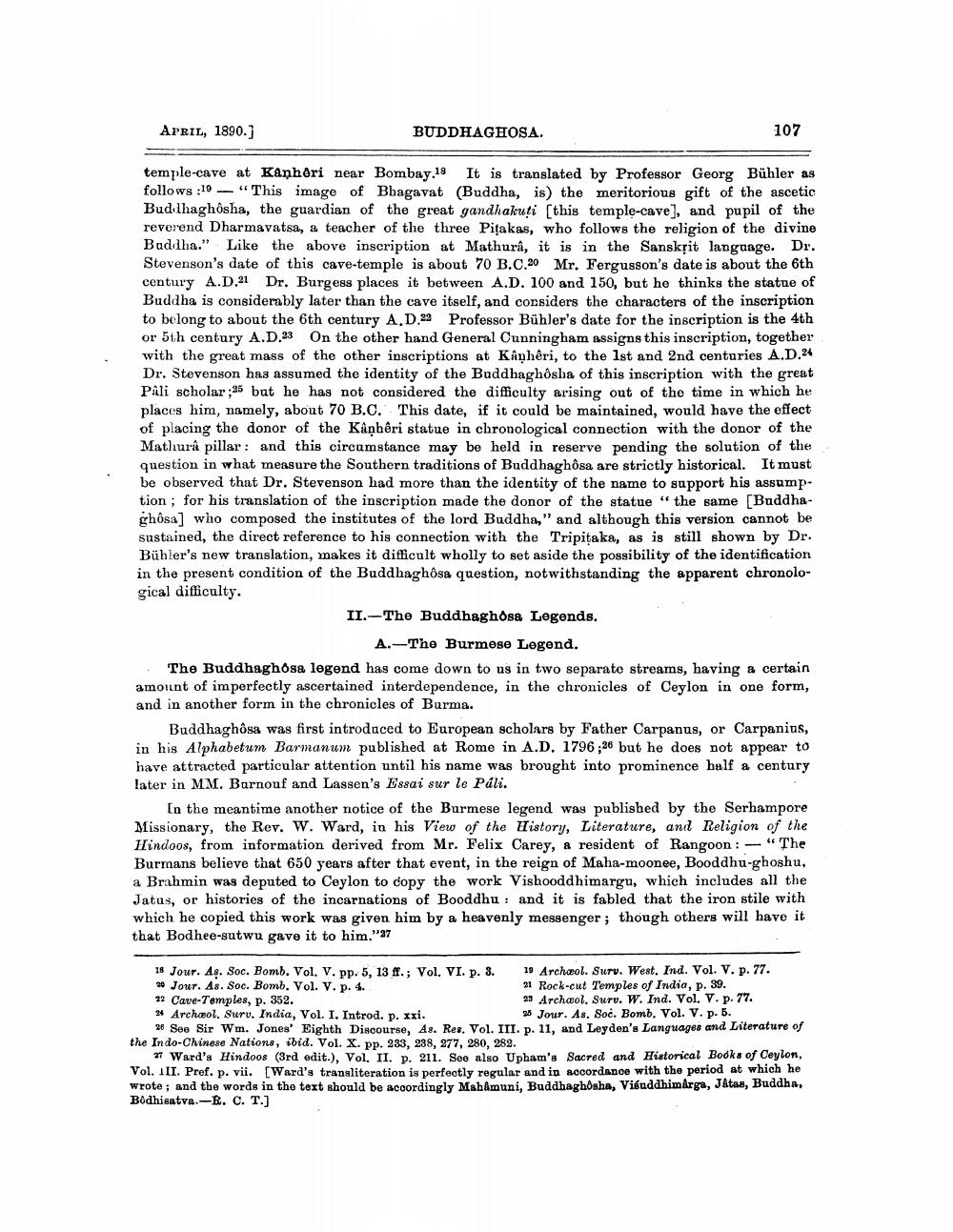________________
APRIL, 1890.)
BUDDHAGHOSA.
107
temple-cave at Kanhöri near Bombay.18 It is translated by Professor Georg Bühler as follows :19 - "This image of Bhagavat (Buddha, is) the meritorious gift of the ascetic Budilhaghôsha, the guardian of the great gandhakuti [this temple-cave), and pupil of the reverend Dharmavatsa, a teacher of the three Pitakas, who follows the religion of the divine Buddha." Like the above inscription at Mathurâ, it is in the Sanskțit language. Dr. Stevenson's date of this cave-temple is about 70 B.C.20 Mr. Fergusson's date is about the 6th century A.D.21 Dr. Burgess places it between A.D. 100 and 150, but he thinks the statue of Buddha is considerably later than the cave itself, and considers the characters of the inscription to belong to about the 6th century A.D.22 Professor Bühler's date for the inscription is the 4th or 5th century A.D.23 On the other hand General Cunningham assigns this inscription, together with the great mass of the other inscriptions at Kavhêri, to the 1st and 2nd centuries A..D.24 Dr. Stevenson has assumed the identity of the Buddhaghosha of this inscription with the great Pali scholar;25 but he has not considered the difficulty arising out of the time in which he places him, namely, about 70 B.C. This date, if it could be maintained, would have the effect of placing the donor of the Kanhêri statue in chronological connection with the donor of the Mathura pillar: and this circumstance may be held in reserve pending the solution of the question in what measure the Southern traditions of Buddhaghôsa are strictly historical. It must be observed that Dr. Stevenson had more than the identity of the name to support his assumption, for his translation of the inscription made the donor of the statue “the same [Buddhaghosa] who composed the institutes of the lord Buddha," and although this version cannot be sustained, the direct reference to his connection with the Tripitaka, as is still shown by Dr. Bühler's new translation, makes it difficult wholly to set aside the possibility of the identification in the present condition of the Buddhaghosa question, notwithstanding the apparent chronological difficulty.
II.-The Buddhaghosa Legends.
A.-The Burmese Legend. The Buddhaghosa legend has come down to us in two separato streams, having a certain amount of imperfectly ascertained interdependence, in the chronicles of Ceylon in one form, and in another form in the chronicles of Burma.
Buddhaghôsa was first introduced to European scholars by Father Carpanus, or Carpanius, in his Alphabetum Barmanum published at Rome in A.D. 1796,26 but he does not appear to have attracted particular attention until his name was brought into prominence half a century later in MM. Burnouf and Lassen's Essai sur le Páli.
In the meantime another notice of the Burmese legend was published by the Serhampore Missionary, the Rev. W. Ward, in his View of the History, Literature, and Religion of the Hindoos, from information derived from Mr. Felix Carey, a resident of Rangoon: -“The Burmans believe that 650 years after that event, in the reign of Maha-moonee, Booddhu-ghoshu, a Brahmin was deputed to Ceylon to copy the work Vishooddhimargu, which includes all the Jatus, or histories of the incarnations of Booddhu : and it is fabled that the iron stile with which he copied this work was given him by a heavenly messenger; though others will have it that Bodhee-sutwu gave it to him.27
18 Jour. As. Soc. Bomb. Vol. V. pp. 5, 138.; Vol. VI. p. 3. 19 Archæol. Sury. West. Ind. Vol. V. p. 77. 20 Jour. As. Soc. Bomb. Vol. V. p. 4.
21 Rock-cut Temples of India, p. 39. 32 Cave-Temples, p. 352.
23 Archæol. Surv. W. Ind. Vol. V. p. 77. 24 Archæol. Surv. India, Vol. I. Introd. p. xxi.
25 Jour. As. Soc. Bomb. Vol. V. p.5. 26 See Sir Wm. Jones' Eighth Discourse, As. Res. Vol. III. p. 11, and Leyden's Languages and Literature of the Indo-Chinese Nations, ibid. Vol. X. pp. 233, 238, 277, 280, 282.
17 Ward's Hindoos (3rd edit.), Vol. II. p. 211. See also Upham's Sacred and Historical Books of Ceylon, Vol. III. Pref. p. vii. [Ward's transliteration is perfectly regular and in accordance with the period at which he wrote; and the words in the text should be accordingly Mah&muni, Buddhaghsha, VifuddhimArge, Jatas, Buddha, Bodhisatva.-R. C. T.]




